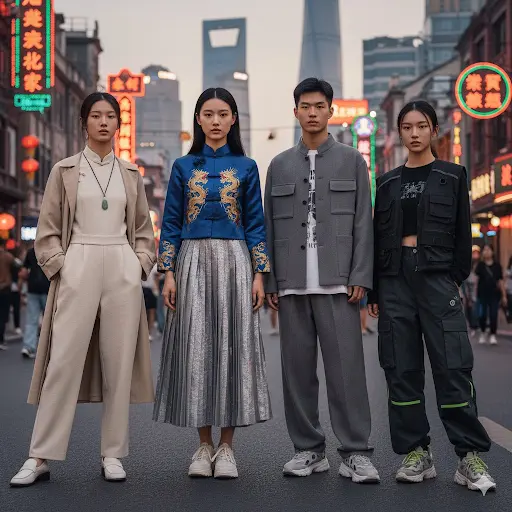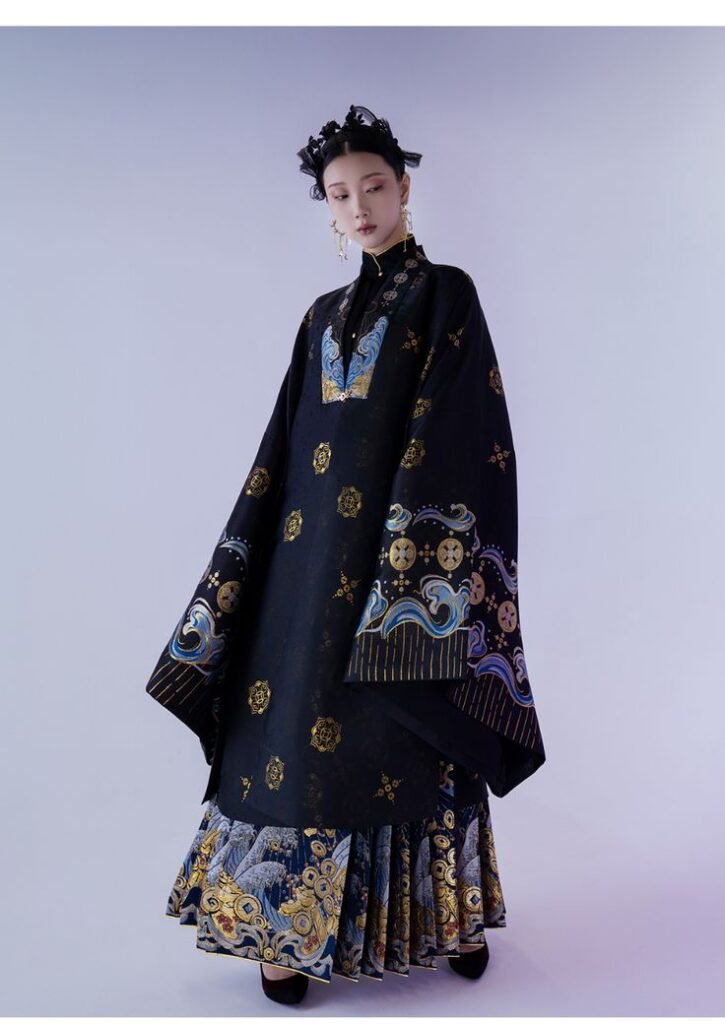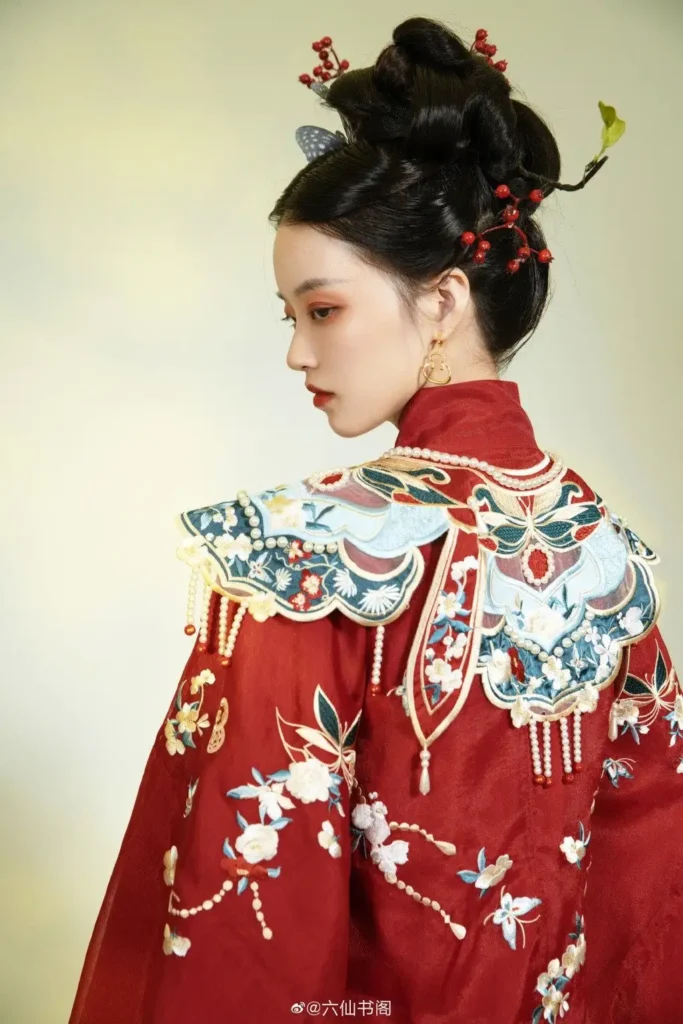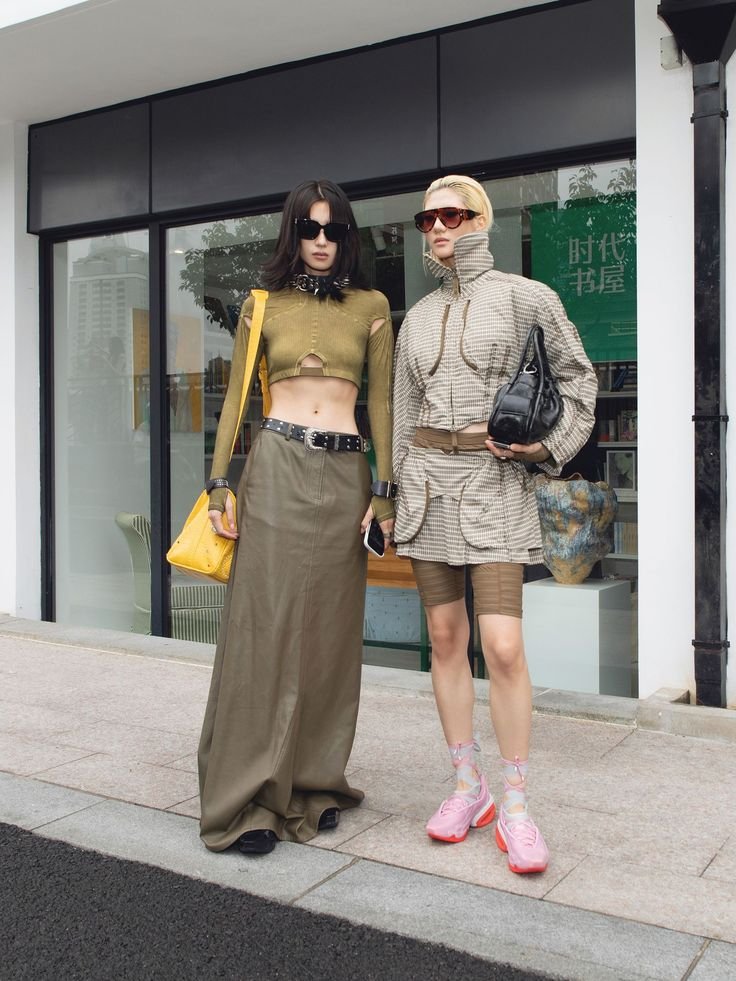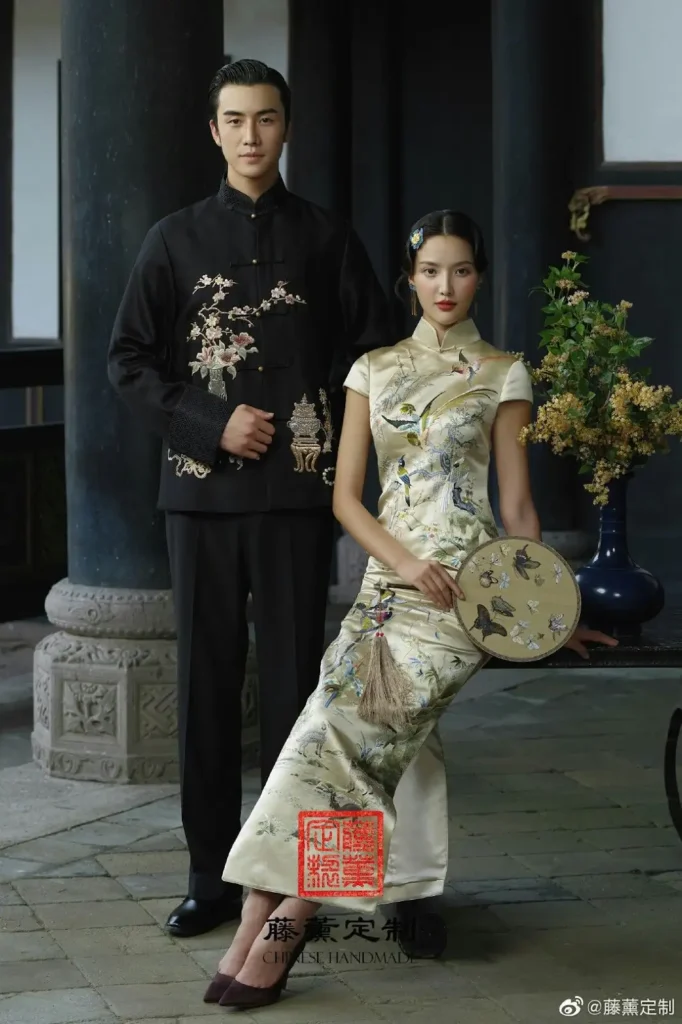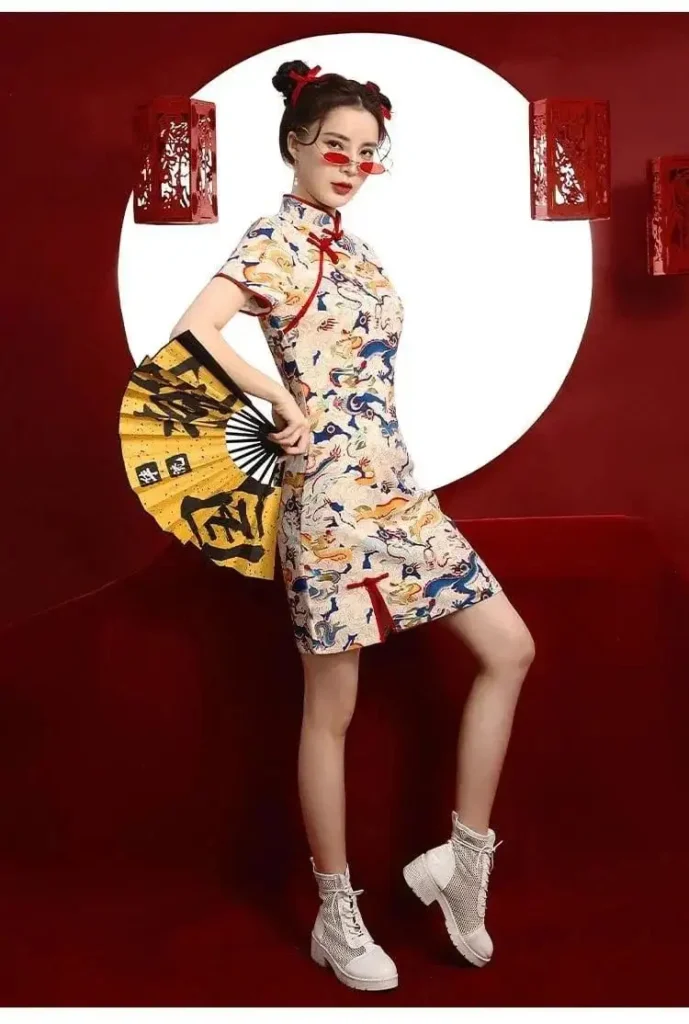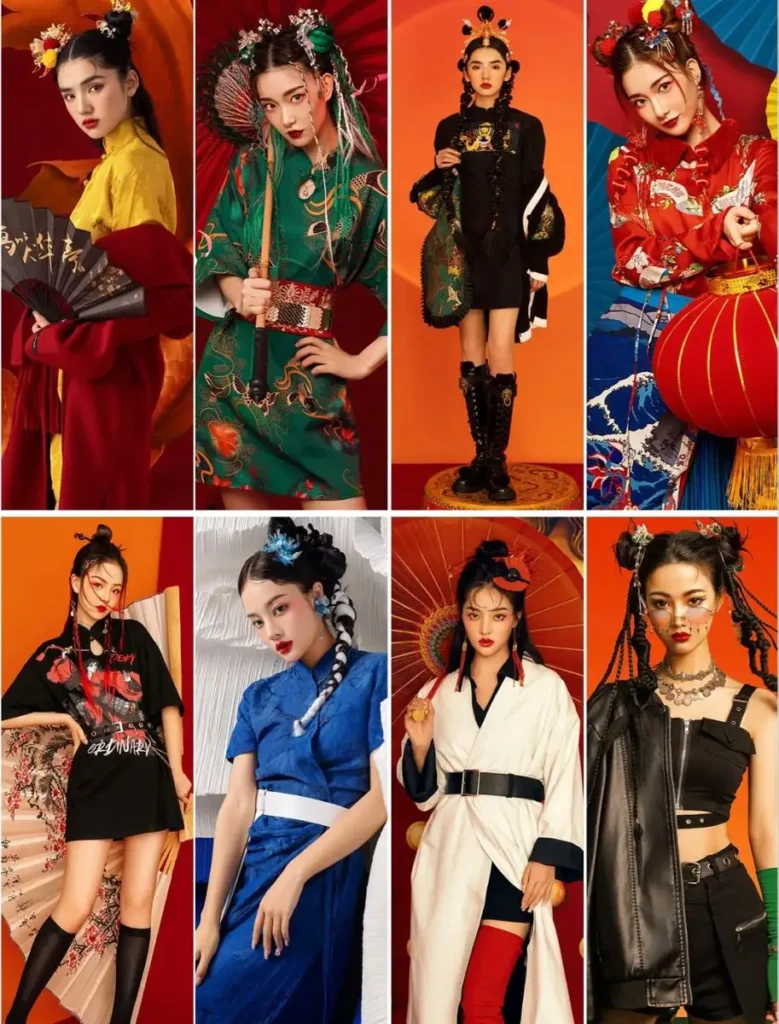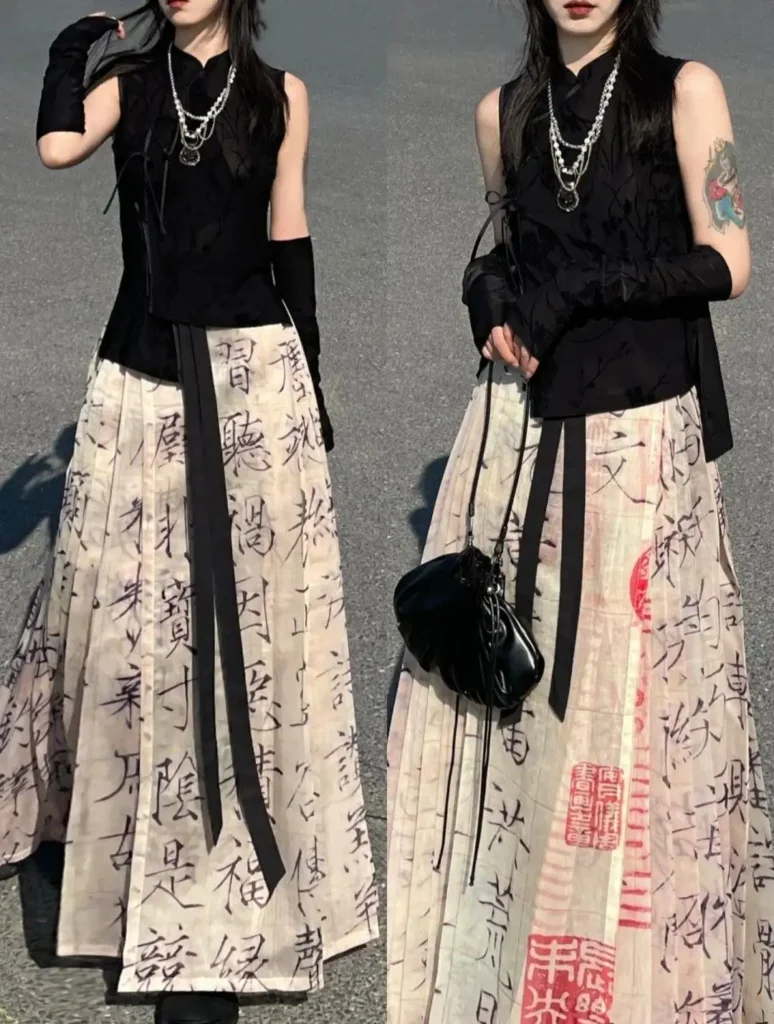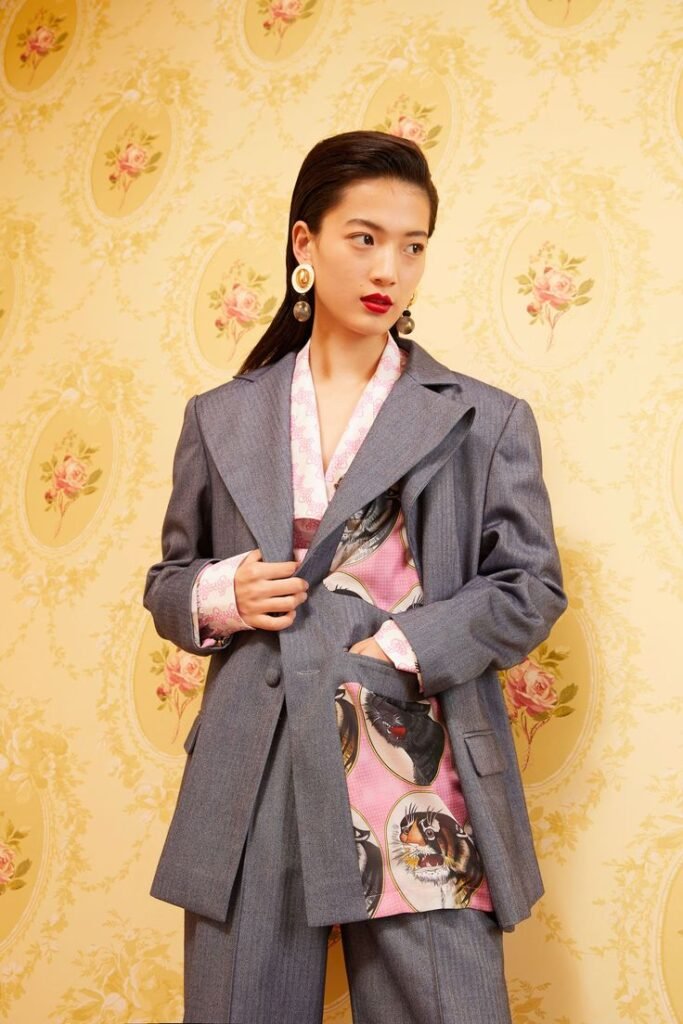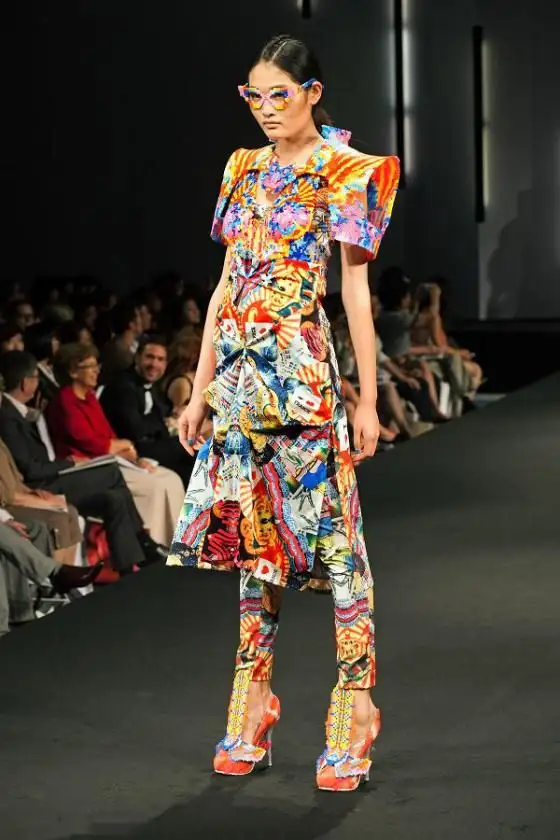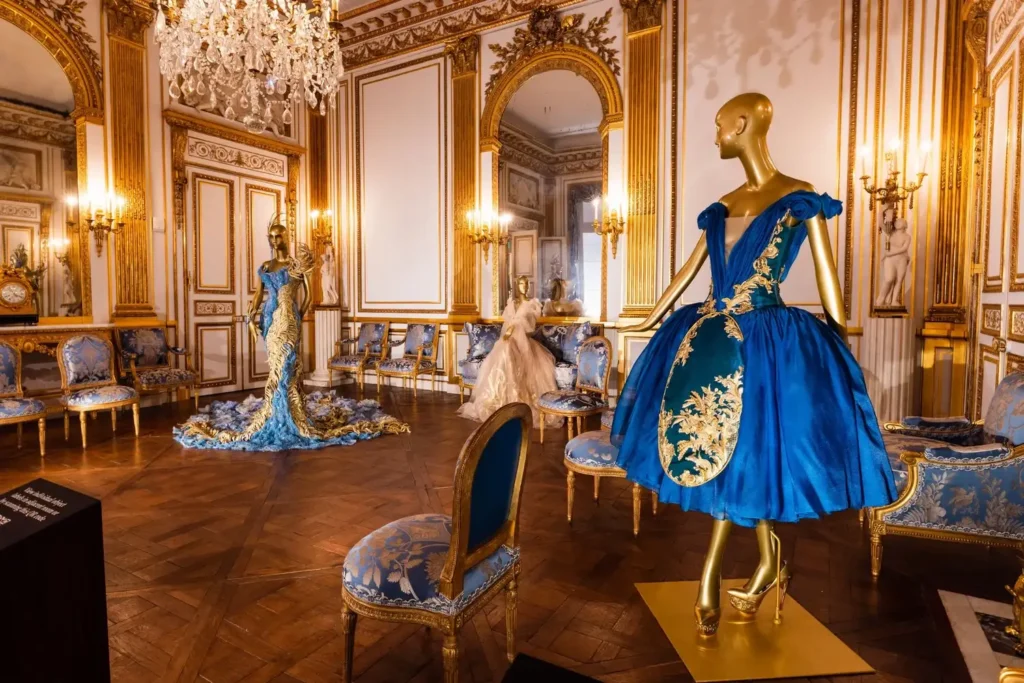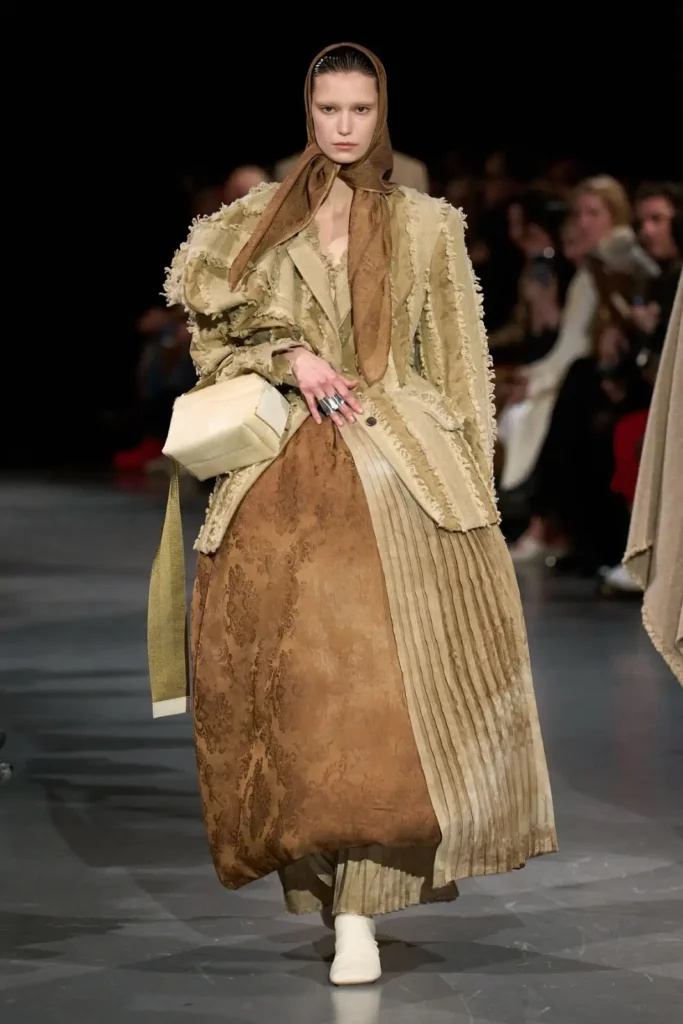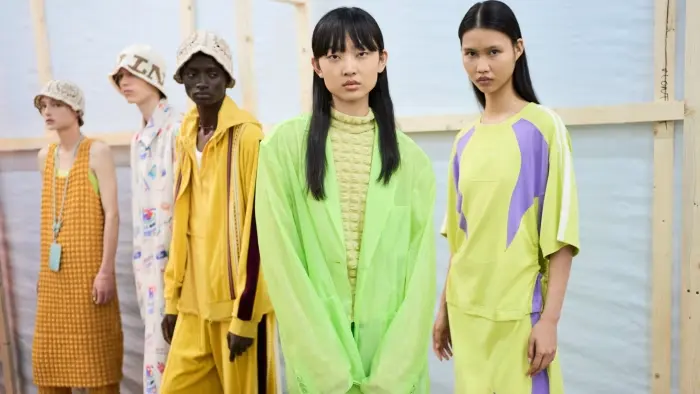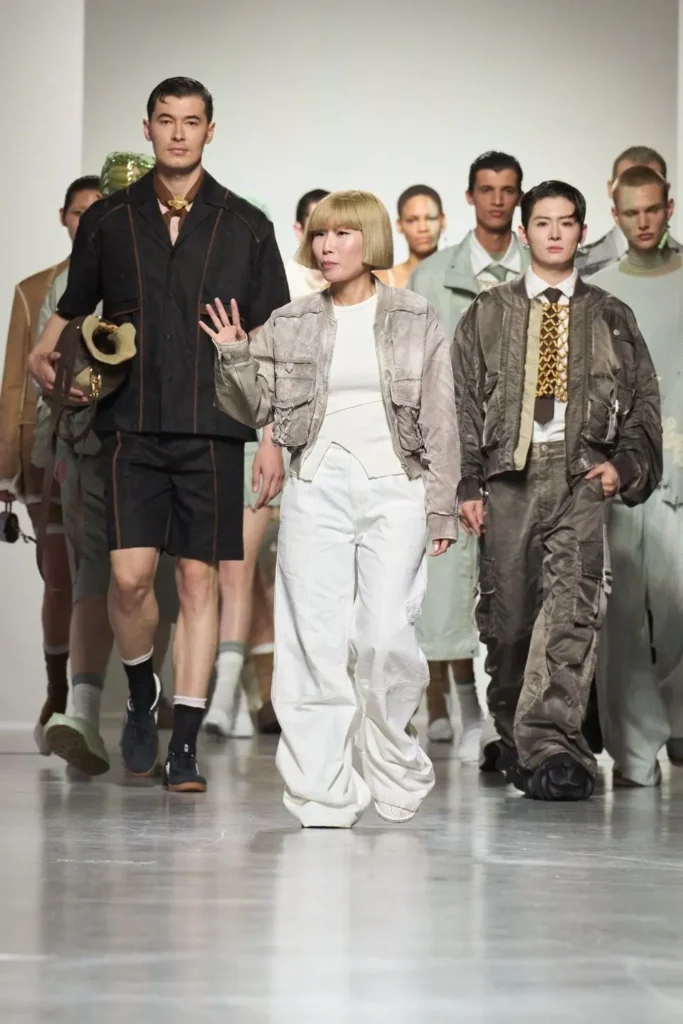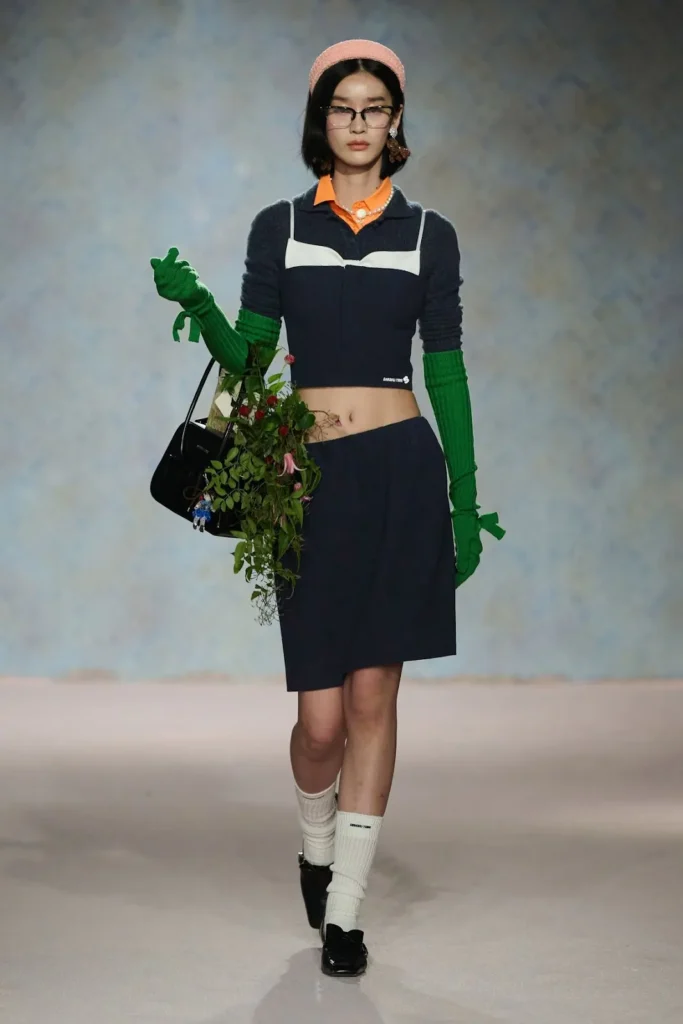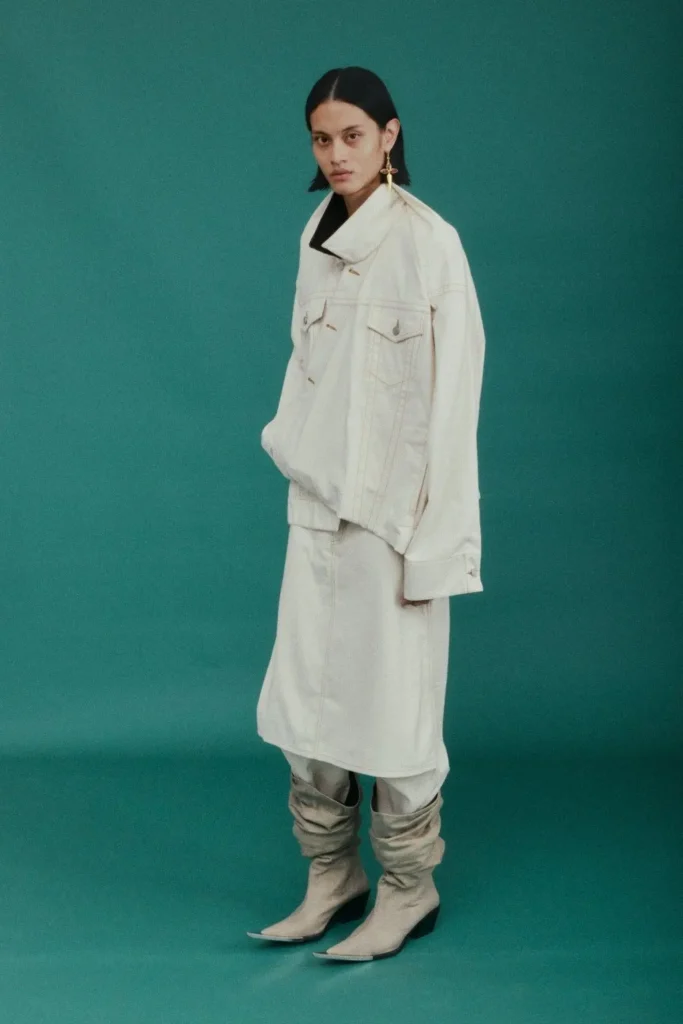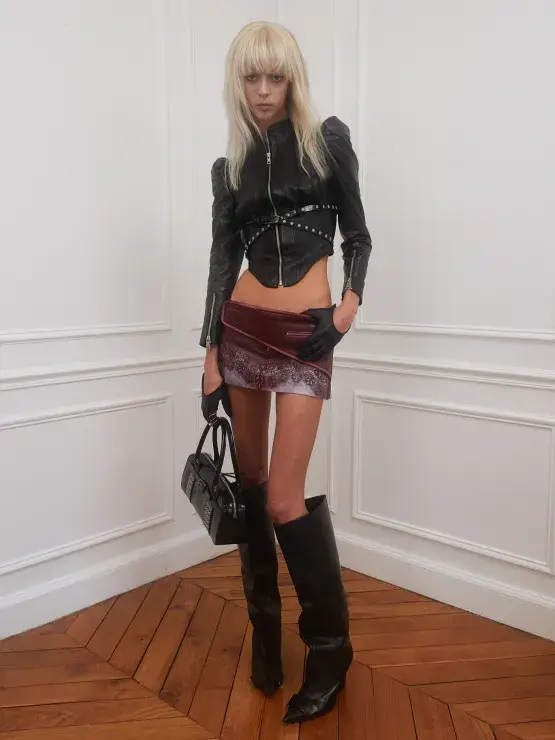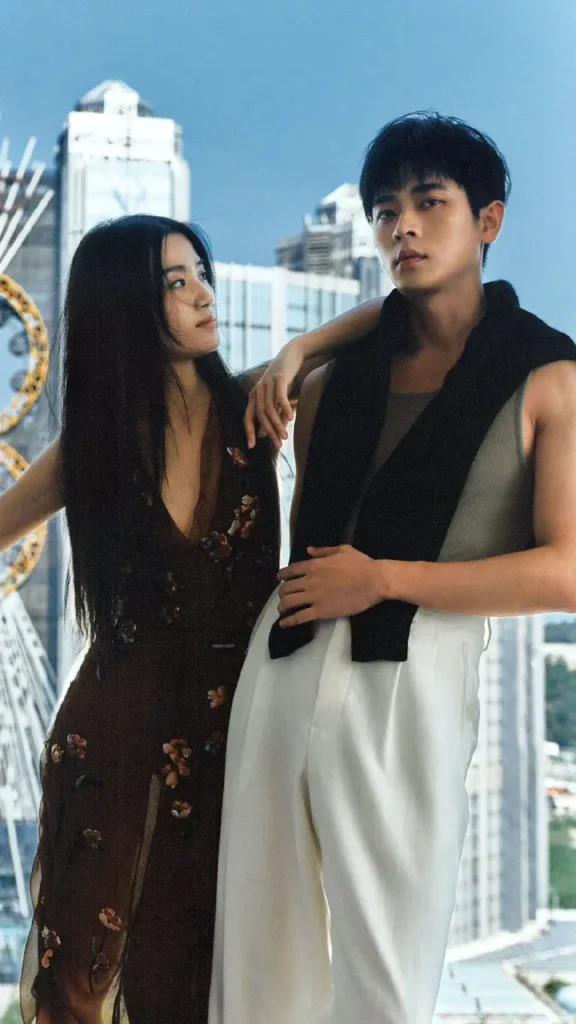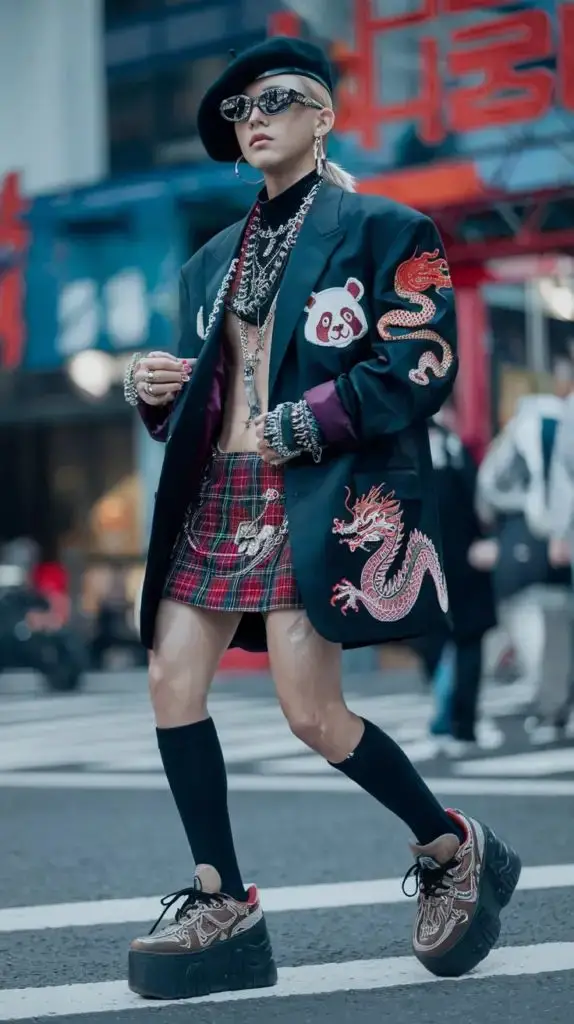The historical period of China established the fundamental design elements which shape present-day fashion through the Guochaochao (National Tide) movement. Modern designers use their skills to combine traditional elements with international fashion trends.
Luxury fashion brands and high-end streetwear designers implement traditional Chinese textile techniques to develop their designs.
The symbolic elements of traditional Chinese design appear in modern graphic elements.
China established itself as a major global fashion market during the last ten years. Shanghai and Beijing along with Shenzhen and Chengdu have developed into major fashion centers that organize yearly fashion events to support emerging designers.
The contemporary Chinese fashion movement known as Guochao (国潮) emerged as the leading commercial force which youngsters, specially Gen Z use to express their cultural pride. The fashion trend combines modern interpretations of traditional Chinese design elements which include dragons, phoenixes, Imperial Yellow, Vermilion Red colors, Qipao and Hanfu silhouettes with modern clothing items including oversized hoodies,shiirts technical outerwear and modern sneakers. The movement represents a fundamental change in consumer behavior because people now choose to support Chinese brands like Li-Ning which showcased deep cultural elements in their runway shows to establish traditional Chinese heritage as a fundamental element of contemporary fashion.
The Hanfu Revival Movement (Hanfu Fuxing Yundong) represents a vital youth-led initiative which promotes the modern use of Hanfu (汉服) as traditional clothing from before the Qing Dynasty. The movement started in 2000 as a small group of enthusiasts who focused on authentic historical clothing but evolved into a popular cultural and fashion movement. Young Chinese citizens now use contemporary versions of traditional clothing items which include jiaoling youren robes with cross-collar designs, wide sleeves, qun skirts and Mamianqun (Horse-Face Skirt) with its structured pleated design for both special events and regular social activities. Youngsters today use this cultural movement to express their identity through fashion because they want to honor China’s extensive and varied historical clothing traditions.
The Neo-Chinese Style (新中式) presents a luxurious design approach which unites Eastern and Western elements through minimalist aesthetics to create high-end fashion. The trend unites traditional Mandarin collar elements with Pankou frog closures and luxurious Chinese fabrics into modern Western clothing designs including blazers, trenches and sophisticated dresses. The design approach uses earthy tones from traditional ink wash paintings to create a sophisticated look that emphasizes expert craftsmanship and premium materials instead of flashy branding according to Uma Wang and Ms MIN.
Chinese cities have seen a massive growth of streetwear fashion because young people embrace hip-hop style and use social media platforms. Young fashion enthusiasts in Shanghai and Chengdu cities choose Opiumcore to wear like oversized hoodies with cargo pants, sneakers with multiple clothing layers also Wasteland Style like post-apocalyptic, deconstructed, and textural the oversized, gender-fluid silhouette. The Chinese clothing market now recognizes Sankuanz, SMFK and Roaringwild as leading brands which merge international street fashion with domestic design elements. The fashion trend in China showcases vibrant designs through its use of Mandarin text and its incorporation of traditional elements such as cloud and lotus motifs. The streetwear trend in China allows young people to express their individuality because they want to escape traditional social expectations.
The fast-paced visual nature of Xiaohongshu and other Chinese social media platforms leads to the rapid development of digital micro-aesthetics which Gen Z users adopt and it transform into new trends. The “Clean Girl” aesthetic presents itself through basic clothing items in neutral colors without logos to create a wellness-focused appearance. The “Girlcore” movement presents a hyper-feminine style which uses bows, ruffles and Mary Jane shoes to create a feminine look that challenges conventional beauty standards. The “Grandpacore” trend combines pleated trousers with knitted vests and vintage loafers to create an eccentric academic style which appeals to people who want to experience comfort in new ways.
China uses its position as a worldwide technology leader to merge innovation with its fashion sector. The combination of AI stylists with virtual fashion shows and AR try-ons has revolutionized the way people interact with clothing during their shopping experiences. Designers now create smart fabrics which adjust their properties based on body heat and physical movements while luxury brands create NFT fashion items for digital characters. Virtual influencers Ayayi and Ling serve as digital fashion icons who showcase the artistic combination of technology and creative expression. China leads the world through its innovative approach which combines digital technology with traditional fashion products.
The modern Chinese fashion industry depends on a talented group of designers and brands who create “China Chic” styles while leading international fashion trends. The top ten entries showcase the highest point of this movement through their combination of high-end fashion and stylish ready-to-wear and successful domestic fashion brands.
The Chinese recognizes Guo Pei as its reigning monarch because she creates theatrical and opulent designs through traditional Beijing embroidery techniques. Through her designs Guo Pei creates wearable masterpieces which draw inspiration from imperial times and mythological stories while her Paris Haute Couture calendar invitation solidifies her position as a worldwide artistic leader.
The world recognizes Angel Chen as a leading young Chinese fashion designer because she creates energetic designs which combine personal style with commercial appeal. The designer uses bold colors and eclectic layering techniques to merge Eastern motifs with Western streetwear and punk elements which has led to successful partnerships with H&M and Canada Goose.
The Guochao (National Tide) movement has made Li-Ning into a worldwide streetwear influencer after the brand started as a Chinese domestic sportswear company. The brand now shows at international fashion shows with designs that draw from Chinese heritage, martial arts and calligraphy which has established them as a national symbol and leader in uniting performance wear with high-fashion street style and Chinese cultural elements.
She stands as a leading conceptual streetwear designer who creates architectural designs through deconstruction and technical advancements that include personal Chinese cultural elements. The London-Shanghai based designer Feng Chen Wang creates strong gender-neutral clothing and works with major brands like Converse to build her position as a leading figure in worldwide Gen Z fashion.
ICICLE stands as a leading company in sustainable luxury because it dedicates itself to eco-conscious practices, natural materials with Chinese philosophical design principles that honor nature. The brand provides upscale clothing with simple designs and understated sophistication which attracts fashionable city dwellers who value sustainable quality above fleeting fashion trends.
Shangguan Zhe established Sankuanz as an experimental streetwear brand which participates in Paris Fashion Week. The brand creates nonconformist clothing with dystopian and futuristic designs that unite urban elements with artistic concepts and occasional Eastern spiritual motifs to establish its unique position in Chinese fashion.
The fashion world recognizes Susan Fang as a designer who creates dreamlike clothing that merges different artistic elements through her mathematical textile production methods. The London and Shanghai fashion scenes have adopted her experimental designs which combine fashion with art and technology through her dreamlike creations and complex beadwork and ‘air weave’ technology.
The fashion label Didu has emerged as a new star in the industry because it presents daring, sensual punk-inspired designs. The Antwerp-trained designer creates clothing that features sheer materials, revealing cutouts and powerful confident designs which have attracted worldwide attention from fashion runways and celebrity stylist clients who appreciate her unreserved modern feminine style.
Modern Chinese clothing fashion exists within a digital environment which continues to evolve through platforms including Weibo, WeChat, Xiaohongshu (Little Red Book) and Douyin (the original TikTok).
Modern Chinese fashion now serves as a global fashion movement which goes beyond its traditional Chinese market. Chinese designers present their cultural heritage through confident displays at Paris, Milan and New York Fashion Weeks. The luxury fashion brands Dior and Louis Vuitton incorporate Chinese cultural elements into their marketing strategies to reach Chinese consumers. The fashion industry employs Chinese fashion to establish soft power by showing modern China as an innovative cultural and artistic hub.
The current popular fashion trends include Guochao (National Tide) and Cleanfit (minimalist, well-cut basics) and Gorpcore (high-end, functional outdoor gear), Girlcore (hyper-feminine aesthetic with bows/lace) and natural-themed styles like Plant-themed wear and Mint Mambo.
The 3-3-3 Rule helps users create multiple outfits by choosing three tops, three bottoms and three shoes which can be mixed and matched for a short period or capsule wardrobe at an affordable price of $15+ each.
The main trend of supporting local brands through design integration between modern and traditional Chinese elements is known as Guochao (国潮) or the “National Tide” (also known as “China Chic”).
The modern People’s Republic of China has not prohibited Hanfu but the Qing Dynasty established a ban on this traditional clothing during the mid-17th century to eliminate Han cultural practices while forcing people to adopt Manchu traditions for national unity purposes. But it’s now a trending Chinese fashion trend popular worldwide.
